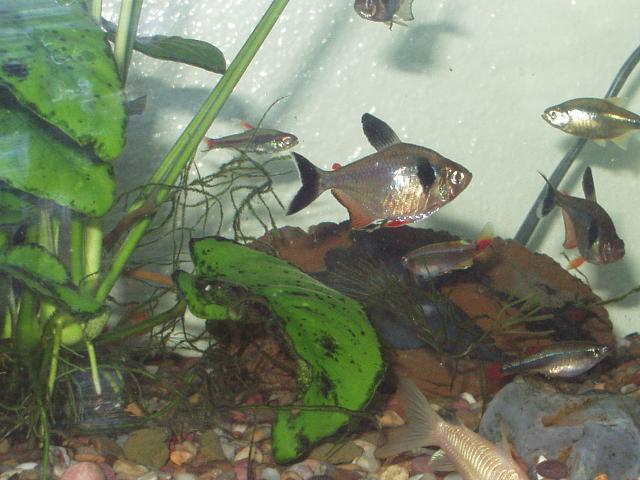
SERPAE TETRAS
Other Names: Hyphessobrycon callistus
Family : Characidae
Origin : South America
Food : flakes, brine shrimp (live or frozen), black worms, blood worms
Temperature Range: 72-82°F.
pH: 5.8-7
Adult Size: 1.75"
Nice community fish, very common & popular.
Fin-nipping fishes are among the most insidious of all such dangers. To the casual observer nothing seems to be wrong, but those fishes with long fins (such as angelfish, gouramis, and siamese fighting fishes) seem to be more ragged than they were. The culprits are those small fishes which have a habit of nibbling on the fins of these fishes. Only a few fishes are really serious 'fin-nippers', and the ones most commonly Serpae or jewel tetra. Possibly the most common tetra available in the hobby. What we see in the stores is the aquarium, or domesticated, form which is more colorful and less likely to fade than the wild variety. Overall dull red with a black shoulder patch, black dorsal fin, red anal fin with a black margin. Dorsal, anal and pelvic fins are tipped with white. Colorful and common as this fish is, it is in essence a bully.
. Do not mix with fancy finned fish, otherwise they are quite suitable for community tanks.
These popular Tetras are very peaceful fish, and they swim in a beautiful school when you have at least 6. With less than 6 or so Serpaes, they don't seem to do very well. I started out with 2, who weren't too happy most of the time, but after getting more, they've really perked up and they're now among my liveliest fish.
Breeding: Pretty easy. Use a heavily planted tank to reduce light levels. Although sensitive to change in new water, it is important to change its water frequently, about 25% a week. Use warmer (80°F), medium hardness water with a pH 6.8. May wish to use water that has been filtered through peat moss. Use one breeding pair at a time. The parents will eat their eggs so remove parents after spawning. Keep tank dark. Young neons are very sensitive to light, until their eyes completely develop.Egg scattering takes place, usually over plants hatching can take about a day. Sexing: Females are slightly larger and wider.